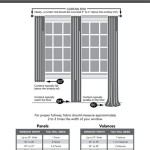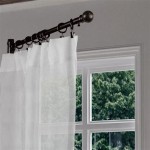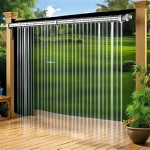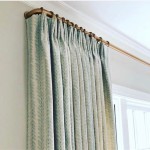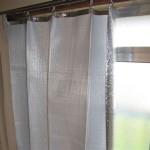Curtains with Hooks on the Back: A Comprehensive Guide
Curtains are a ubiquitous element of interior design, providing aesthetic appeal, privacy, and light control. The method of hanging curtains varies, with one popular option being curtains featuring hooks on the back. This style offers a unique blend of functionality and elegance, often resulting in a more tailored and sophisticated appearance compared to simpler hanging methods like rod pockets or grommets.
Curtains with hooks on the back, sometimes referred to as pleated curtains or drapery with back tabs, are designed to be suspended from a curtain rod using hooks inserted into fabric loops or pleats sewn onto the back of the curtain panel. This system allows for a more controlled and evenly distributed weight, leading to a cleaner and more professional drape. This article will delve into the various aspects of curtains with hooks on the back, exploring their benefits, different styles, installation methods, and considerations for selection and maintenance.
Understanding the Benefits of Curtains with Hooks on the Back
Curtains with hooks offer several advantages that contribute to their popularity. One key benefit is their ability to create a more polished and elegant look. The hooks allow the curtain to hang in defined folds or pleats, enhancing the overall visual appeal of the window treatment. The even distribution of weight helps the fabric drape smoothly from top to bottom, minimizing unsightly sagging or bunching. This creates a more tailored and sophisticated appearance in comparison to curtains that are simply gathered or threaded onto a rod.
Another advantage is the ease of adjusting the curtain's fullness. By manipulating the spacing of the hooks, the user can control the density of the pleats, thereby altering the amount of fabric used to cover the window. This flexibility allows for customization based on personal preference and the specific dimensions of the window. For example, closer hook placement will result in denser, fuller pleats, while wider spacing will create looser, more relaxed folds.
Furthermore, hook-backed curtains often provide a more secure and stable hanging system. The hooks are designed to distribute the weight of the curtain more evenly across the rod, reducing the risk of slippage or sagging, especially with heavier fabrics. This ensures that the curtains maintain their position and appearance over time, requiring less frequent adjustments. The secure attachment also makes them a suitable choice for high-traffic areas or homes with children or pets.
Exploring Different Styles and Designs
Curtains with hooks on the back are available in a wide range of styles and designs to complement various interior design aesthetics. The type of pleat used is a significant factor in determining the overall appearance of the curtains. Common pleat styles include pinch pleat, goblet pleat, and pencil pleat, each offering a distinct visual effect.
Pinch pleat curtains feature evenly spaced bunches of fabric that are pinched and sewn together at the top, creating a tailored and structured look. This style is often associated with classic or formal interiors. The pleats are typically reinforced with buckram or stiffening material to maintain their shape and create a crisp, clean line. Variations include single, double, and triple pinch pleats, each offering a different level of fullness and formality.
Goblet pleat curtains are characterized by their rounded, goblet-shaped pleats at the top. This style adds a touch of elegance and sophistication to any room. The goblet shape is created by stuffing the pleat with batting or other filling material, which helps to maintain its form. Goblet pleats are often used in more formal or luxurious settings.
Pencil pleat curtains feature narrow, tightly packed pleats that resemble a row of pencils. This style is versatile and can be adapted to both casual and formal settings. Pencil pleats are created using a special heading tape that is sewn onto the back of the curtain fabric. The tape has cords that are pulled to gather the fabric into the desired pleat density. This style offers a more relaxed and understated look compared to pinch pleat or goblet pleat curtains.
Beyond the pleat style, curtains with hooks are also available in a variety of fabrics, colors, and patterns. The choice of fabric will significantly impact the appearance and functionality of the curtains. Heavier fabrics, such as velvet or brocade, offer better light blocking and insulation, while lighter fabrics, such as linen or cotton, allow more light to filter through and create a more airy feel. The color and pattern of the curtains should be chosen to complement the existing décor of the room.
Installation and Maintenance Considerations
Installing curtains with hooks on the back requires careful planning and attention to detail. The first step is to measure the window accurately to determine the appropriate curtain width and length. It is important to consider the desired fullness of the curtains when calculating the width. A general rule of thumb is to multiply the window width by 1.5 to 2.5 to achieve adequate fullness. The length should be measured from the top of the curtain rod to the desired hemline, taking into account the desired floor clearance or pooling effect.
Once the measurements have been taken, the next step is to install the curtain rod. The rod should be positioned at the appropriate height above the window to allow the curtains to hang correctly. The mounting brackets should be securely attached to the wall studs or using appropriate wall anchors to support the weight of the curtains. Consider the style of curtain rod that best complements the curtains and the room décor; options include decorative rods, traverse rods, and combination rods.
After the rod is installed, the hooks can be inserted into the back of the curtain panel. The spacing of the hooks will depend on the desired pleat density and the type of hook being used. It is important to ensure that the hooks are evenly spaced to create a balanced and uniform drape. Once the hooks are in place, the curtains can be hung on the rod by attaching the hooks to the rings or carriers on the rod. Ensure the hooks latch securely to prevent the curtains from slipping or falling.
Maintaining curtains with hooks on the back will help to prolong their lifespan and keep them looking their best. Regular dusting or vacuuming will help to remove dust and dirt that can accumulate on the fabric. Depending on the fabric type, the curtains may need to be dry cleaned or hand washed periodically. Always follow the manufacturer's instructions for cleaning and care. Harsh detergents or excessive heat can damage the fabric and alter its appearance. For delicate fabrics, professional cleaning is recommended.
In addition to regular cleaning, it is important to address any stains or spills promptly. Blot the stain gently with a clean cloth, avoiding rubbing, which can spread the stain. Use a mild detergent or stain remover that is appropriate for the fabric type. Test the cleaning solution on an inconspicuous area of the curtain first to ensure that it does not damage the fabric or cause discoloration.
Finally, protect the curtains from excessive sunlight and moisture. Prolonged exposure to sunlight can cause fading and discoloration. Consider using window film or blinds to block harmful UV rays. Moisture can lead to mildew and mold growth, especially in humid environments. Ensure adequate ventilation in the room and address any leaks or moisture problems promptly.
Selecting the appropriate curtains with hooks on the back involves considering various factors, including the desired aesthetic, the functionality requirements of the room, and the budget. It is important to choose a style and fabric that complement the existing décor and provide the desired level of light control and privacy. Consider the weight and durability of the fabric, as well as the ease of cleaning and maintenance. By carefully considering these factors, individuals can select curtains with hooks that enhance the beauty and functionality of their homes for years to come.

Where To Fit Curtain Tie Back Hooks For The Best Look

Ikiriska Add Curtain Tape With Hooks To Our Custom Curtains Perfect For Ceiling Track System Or Rods Rings Use As Back Tab 50 Panel

Hand Hook Curtain Holdback Wall Hooks Coat Tie Backs Cast Iron Metal Back Pull Etsy

Curtain Tie Backs Hook Decorative Wall Black Design Set Of Two

Leather Tieback V Ed End Curtain Hooks Nursery Window Treatments Tie Back Holder Rustic Decor Loop Scandinavian Modern Etsy

Curtain Tie Back Hanger Simple Modern Design Wall Hooks Minimal Holdback Hook Metalic Decor Valentines Gift

2pcs Curtain Tieback Side Hooks Tie Back Vintage Wall

4 Pack Black Cotton Window Curtain Tiebacks Tie Back With 8 Hooks 26 Holdbacks Rope For Drapes

2pcs Curtain Holdback Wall Mounted Drapery Tiebacks Heavy Duty Metal Decorative Window Holder Multifunctional Durable Hooks

2pcs Curtain Holdbacks Flower Pattern Tiebacks Hooks

